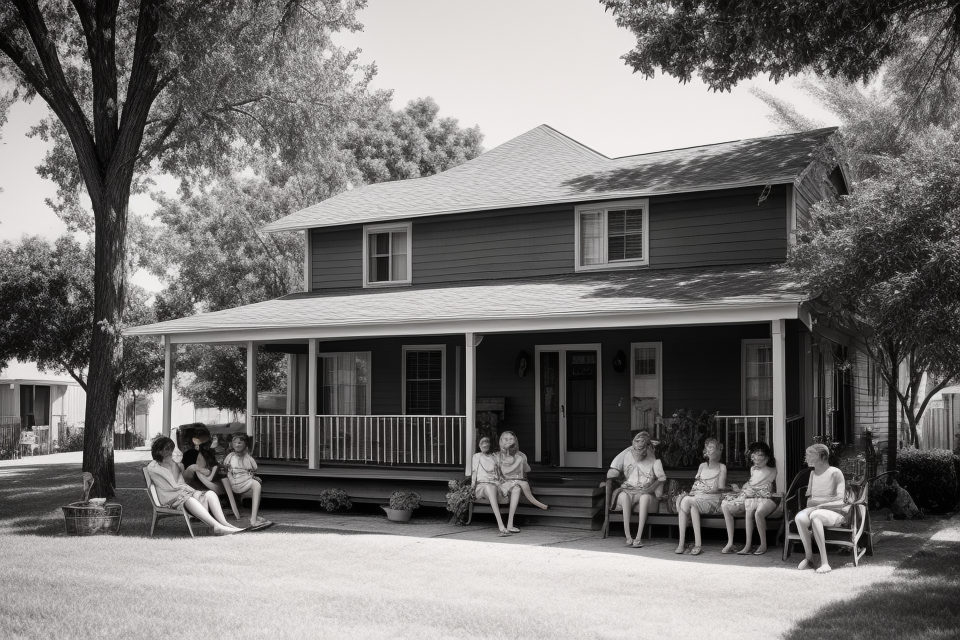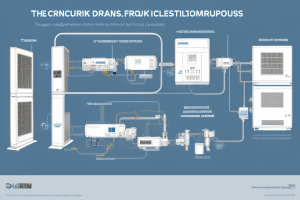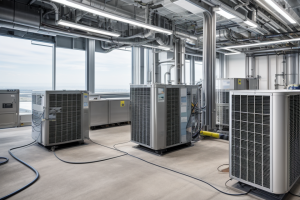
Summer days can be sweltering, and the scorching heat can make it challenging to carry out daily activities. But have you ever wondered how people managed to stay cool before air conditioning was invented? The answer lies in the fascinating history of cooling methods that date back to ancient times. In this article, we’ll explore the unique cooling requirements before air conditioning and uncover the creative ways people used to beat the heat. Get ready to embark on a journey through time and discover the ingenious techniques used by our ancestors to keep cool in the sweltering heat.
The Importance of Cooling in Ancient Times
The Effects of Heat on Human Health
- Heat-related illnesses
- Heat exhaustion
- Symptoms: headache, dizziness, nausea, muscle cramps, and heavy sweating
- Causes: prolonged exposure to high temperatures, leading to dehydration and salt depletion
- Heatstroke
- Symptoms: high body temperature, headache, confusion, seizures, and loss of consciousness
- Causes: severe dehydration and overexposure to high temperatures
- Heat exhaustion
- Dehydration
- Impact on the body: dehydration can cause fatigue, dizziness, and weakness
- Risk factors: excessive sweating, high ambient temperatures, and prolonged physical activity in the heat
- Humidity and its impact
- Increased risk of heat-related illnesses: high humidity levels can exacerbate the effects of heat on the human body
- Effects on comfort: high humidity levels can make it feel hotter than the actual temperature, reducing the body’s ability to cool down
Cooling Methods in Ancient Civilizations
Evaporative Cooling
Evaporative cooling, also known as swamp cooling, was used in ancient civilizations to keep indoor spaces cool. This method involves the use of water to reduce the temperature of the air. In ancient Rome, for example, water was circulated through a series of channels and fountains to cool the air in the interior of buildings.
Passive Solar Design
Passive solar design is another cooling method that was used in ancient times. This technique involves the use of the sun’s energy to heat a building during the winter and keep it cool during the summer. In ancient Greece, buildings were designed to take advantage of the cooling breezes that blew across the country. The windows and doors of these buildings were oriented to catch the breeze and allow it to flow through the interior.
Shading Techniques
Shading techniques were also used in ancient civilizations to keep indoor spaces cool. In ancient Egypt, buildings were designed with deep overhangs to provide shade from the intense sun. The walls of these buildings were also painted white to reflect the sun’s rays and keep the interior cool. In ancient China, awnings were used to provide shade from the sun and protect the interior of buildings from the heat.
Adapting to Climate Variations
Regional Differences in Cooling Techniques
Climate plays a significant role in determining the cooling techniques used in different regions. Factors such as temperature, humidity, and wind patterns vary from one region to another, requiring specific strategies for effective cooling.
Mediterranean climate
The Mediterranean climate is characterized by hot, dry summers and mild, wet winters. In regions with this climate, the focus is on creating comfortable indoor spaces during the hot summer months. Windows are designed to allow for cross ventilation, while external shutters are used to block out the sun’s rays and keep the interior cool. In addition, the use of insulation and shading materials helps to maintain a comfortable temperature throughout the day.
Desert climate
Desert climates are known for their extreme temperatures, with scorching hot days and freezing cold nights. In these regions, cooling strategies are focused on minimizing heat gain during the day and retaining heat at night. Building orientation and design play a crucial role in achieving this, with homes often constructed with thick walls and small windows to minimize heat loss. Additionally, insulation and shading are used to help regulate indoor temperatures, while the use of passive cooling techniques such as evaporative cooling and natural ventilation is also common.
Tropical climate
Tropical climates are characterized by high temperatures and high humidity levels year-round. In these regions, the focus is on controlling humidity as well as temperature. Homes are designed with large, open spaces to allow for cross ventilation, while roof overhangs and shading devices are used to block out the sun’s rays. Additionally, the use of insulation and air conditioning is common, as these techniques are effective at controlling both temperature and humidity levels.
In conclusion, the unique cooling requirements of different regions are determined by factors such as temperature, humidity, and wind patterns. As a result, the strategies used to keep indoor spaces cool vary from one region to another, with a focus on minimizing heat gain during the day and retaining heat at night in desert climates, controlling humidity as well as temperature in tropical climates, and creating comfortable indoor spaces during the hot summer months in Mediterranean climates.
Cooling Technologies in Different Cultures
Before the advent of modern air conditioning, cultures around the world developed their own unique cooling technologies to cope with extreme heat. From wind towers in the Middle East to iced drinks in China and underground houses in Europe, these innovative solutions helped people survive and thrive in hot climates.
Middle Eastern Wind Towers
Wind towers, also known as barjeel or badgir, have been used in the Middle East for centuries to capture and distribute cool breezes. These towering structures, typically made of mud or stone, are designed to funnel wind into a central courtyard or room, creating a refreshing cross draft. The towers are often topped with a “wind catcher,” a screen or mesh that directs the wind into the tower’s interior. By using the natural movement of air, these towers provided a simple yet effective means of cooling homes and buildings before the advent of modern air conditioning.
Chinese Iced Drinks
In China, where summers can be sweltering, iced drinks have been a traditional way to beat the heat for centuries. These refreshing beverages, often made from fruit, herbs, and sweetener, are served over ice to help lower the body’s core temperature. Besides providing hydration, iced drinks also offer a cooling sensation as the ice melts in the mouth, helping to alleviate the discomfort of high temperatures. In addition to drinks, Chinese culture also features a variety of desserts, such as ice cream and popsicles, that serve the same purpose of providing a cooling respite from the heat.
European Underground Houses
In Europe, where summers can be warm but winters are harsh, underground houses were developed as a means of providing year-round comfort. These homes, often dug into hillsides or constructed beneath earth mounds, take advantage of the earth’s natural insulation to maintain a consistent, cool temperature. The thick walls and earthen roofs of these houses also help to regulate temperature, keeping the interior cool during the summer months. Additionally, these houses often feature small windows and few external openings, further contributing to their ability to retain a comfortable temperature.
The Rise of Air Conditioning
The Invention of Modern Air Conditioning
In the early 20th century, the need for cooling systems that could effectively combat the heat became more pressing. Willis Carrier, a engineer, played a crucial role in the development of modern air conditioning systems. He patented the first air conditioner in 1902, which was originally designed to improve the air quality in a Brooklyn, New York printing plant.
Carrier’s invention consisted of a device that circulated air over cold coils containing ice, which helped to lower the temperature of the air. This basic principle of cooling through the use of evaporation and compression remains the foundation of modern air conditioning systems today.
As demand for cooling solutions increased, the technology continued to evolve. The development of the first modern air conditioning system, known as the “automatic air conditioner,” was introduced in 1928. This system used a compressor, a condenser, and a thermostat to regulate the temperature of the building it was installed in.
Over time, air conditioning systems became more sophisticated and energy-efficient, leading to widespread adoption across various industries. Today, air conditioning is an essential component in many buildings, from homes and offices to data centers and hospitals, helping to provide a comfortable indoor environment for occupants.
The Impact of Air Conditioning on Society
Air conditioning has had a profound impact on society since its widespread adoption in the mid-20th century. From changes in architecture and design to the growth of the economy, air conditioning has transformed the way we live and work.
Changes in Architecture and Design
One of the most significant changes brought about by air conditioning is the way buildings are designed. In hot climates, traditional architecture often relied on natural ventilation and shading to keep buildings cool. However, with the advent of air conditioning, buildings could be designed to be more enclosed and energy-efficient, allowing for greater control over indoor temperatures. This shift in design principles has had a profound impact on the built environment, leading to the creation of new architectural styles and techniques.
Growth of the Economy
Air conditioning has also played a significant role in the growth of the economy. In hot climates, productivity often declines during the summer months as people struggle to stay cool. However, with air conditioning, businesses can operate year-round, leading to increased productivity and economic growth. Additionally, the widespread adoption of air conditioning has created new industries and job opportunities, from manufacturing and installation to maintenance and repair.
Energy Consumption and Environmental Concerns
While air conditioning has brought numerous benefits, it has also led to increased energy consumption and environmental concerns. In many cases, air conditioning units are powered by fossil fuels, leading to increased greenhouse gas emissions and climate change. Additionally, the widespread use of air conditioning has put a strain on electricity grids, leading to blackouts and other power disruptions. As a result, there is a growing need for more energy-efficient and sustainable cooling technologies to meet the demands of a warming world.
Innovations in Cooling Technologies
Sustainable Cooling Methods
Sustainable cooling methods involve using natural resources and energy-efficient technologies to provide comfortable indoor environments while minimizing environmental impact. These methods can be categorized into passive cooling techniques, green roofs and walls, and water features.
- Passive cooling techniques rely on natural ventilation and solar shading to regulate indoor temperature. These techniques include the following:
- Cross ventilation: This involves using windows and doors to allow air to flow through a building, creating natural air circulation.
- Natural shading: This technique employs shading devices, such as overhangs, louvers, and screens, to reduce solar heat gain.
- Insulation: Proper insulation of a building can prevent heat loss during winter and heat gain during summer, leading to a more comfortable indoor environment.
- Green roofs and walls are vegetated surfaces that provide shading, insulation, and evaporative cooling. They also absorb rainwater, reducing stormwater runoff and contributing to urban heat island mitigation. Green roofs and walls can be installed on both new and existing buildings.
- Water features, such as fountains and ponds, can provide evaporative cooling by releasing cool air into the surrounding environment. Water features can also improve the aesthetic appeal of a building and provide a calming presence for occupants.
By implementing sustainable cooling methods, it is possible to create comfortable indoor environments while minimizing energy consumption and reducing environmental impact. These methods are particularly useful in hot and humid climates, where traditional air conditioning systems can be expensive and resource-intensive.
Smart Cooling Solutions
In today’s world, smart cooling solutions have emerged as a promising alternative to traditional air conditioning systems. These advanced technologies not only help in maintaining the comfort levels within a building but also contribute towards energy conservation. In this section, we will explore the different types of smart cooling solutions available in the market.
- Smart ventilation systems: Smart ventilation systems are designed to optimize the indoor air quality by controlling the amount of fresh air that enters a building. These systems use sensors to monitor the temperature, humidity, and air quality and adjust the ventilation accordingly. For instance, during the summer months, these systems can bring in more fresh air while recirculating the air during the winter to maintain a comfortable temperature.
- Energy-efficient air conditioning: Energy-efficient air conditioning systems are designed to reduce the energy consumption while maintaining the cooling efficiency. These systems use advanced technologies such as inverter compressors, variable refrigerant flow, and smart thermostats to optimize the cooling output based on the occupancy and ambient conditions. By reducing the energy consumption, these systems not only help in reducing the carbon footprint but also lead to significant cost savings in the long run.
- IoT-based cooling solutions: IoT-based cooling solutions use the internet of things (IoT) technology to optimize the cooling efficiency and provide remote access and control. These systems use sensors and actuators to monitor the temperature, humidity, and occupancy and adjust the cooling output accordingly. The smart thermostats and mobile apps provide the users with the ability to control the temperature remotely, making it easier to maintain a comfortable environment. Additionally, these systems can be integrated with other smart home devices, providing a seamless user experience.
In conclusion, smart cooling solutions offer a range of benefits over traditional air conditioning systems. These advanced technologies help in optimizing the indoor air quality, reducing the energy consumption, and providing remote access and control. As the demand for energy-efficient and sustainable cooling solutions continues to grow, smart cooling technologies are expected to play a significant role in shaping the future of building comfort.
FAQs
1. What were some common methods used to stay cool before air conditioning was invented?
Before air conditioning was invented, people used a variety of methods to stay cool. Some common methods included using fans, opening windows to allow for cross ventilation, using cold water to bathe and wash clothes, and sleeping on cooler surfaces such as straw or feather mattresses. People also used natural shade and planted trees to provide shade and block the sun.
2. How did people cool their homes before air conditioning?
Before air conditioning, people used a variety of methods to cool their homes. Some common methods included using evaporative coolers, which worked by blowing air over water-soaked pads to lower the temperature, and using ice to cool the air. People also used shutters and window coverings to block the sun and keep the house cool. In addition, people used insulation and weatherstripping to keep the house cool during hot weather.
3. How did people stay cool in hot climates before air conditioning?
In hot climates, people used a variety of methods to stay cool before air conditioning was invented. Some common methods included using shade structures, such as tents or awnings, and using natural ventilation by opening windows and doors. People also used water features, such as fountains or pools, to cool the air and provide a refreshing breeze. In addition, people used cooling fabrics, such as linen and cotton, to stay cool and comfortable.
4. How did people stay cool in public places before air conditioning?
In public places, people used a variety of methods to stay cool before air conditioning was invented. Some common methods included using large fans or blowers to circulate air, using natural ventilation by opening windows and doors, and using shade structures, such as tents or awnings. In addition, people used cold drinks and ice to cool down, and some public places even had cold showers or baths available for patrons to use.
5. What impact did the invention of air conditioning have on society?
The invention of air conditioning had a significant impact on society. It allowed people to cool their homes and workplaces to a comfortable temperature, regardless of the weather outside. This led to increased productivity and comfort, and allowed people to live and work in hot climates without discomfort. In addition, the widespread use of air conditioning led to the development of new technologies and the creation of new industries, such as the HVAC (heating, ventilation, and air conditioning) industry.







